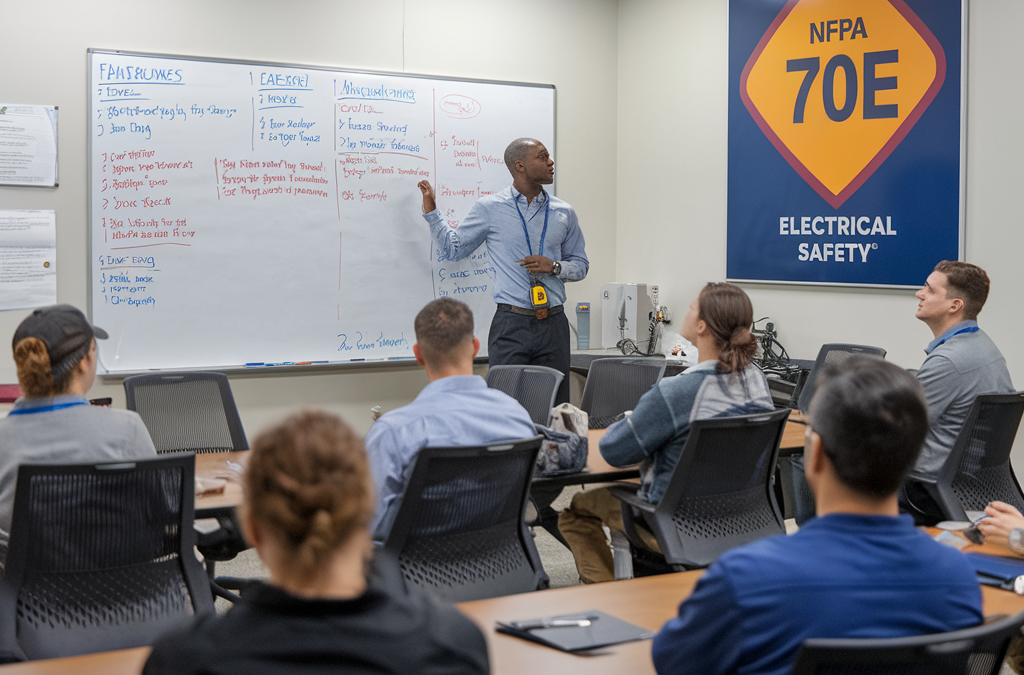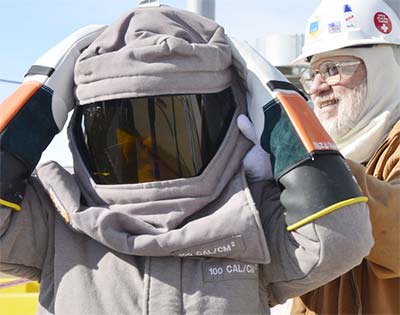Train the trainer programs are a smart way for companies to spread knowledge quickly and effectively. These programs teach experts how to teach others, creating a ripple effect of learning throughout an organization. Let’s look at what these programs are about and how they can help keep workers safe, especially when it comes to electrical hazards.
Key Takeaways
- Train the trainer programs create a multiplier effect for knowledge sharing
- Effective programs include quality content, clear processes, and hands-on activities
- Electrical safety training focuses on NFPA 70E standards and practical application
- Adult learning principles are crucial for engaging and effective training
- Evaluation and ongoing support are essential for program success
What’s a Train the Trainer Program?
Imagine you’re really good at something – like staying safe around electricity. A train the trainer program helps you share that knowledge with your coworkers. It’s like learning to be a teacher, but for grown-ups and about specific job skills. These programs are great because they save money, keep training consistent, and help information spread fast within a company.
BCH Safety offers a train the trainer program that’s all about electrical safety. They focus on teaching the rules from something called NFPA 70E, which is like a rulebook for staying safe around electricity at work. Their goal is to make sure everyone knows how to avoid getting hurt by electrical accidents.
What Makes a Good Train the Trainer Program?
A really good train the trainer program has a few key parts. First, it needs top-notch content – that means the information being taught is accurate and up-to-date. Second, it should be easy to follow, with clear steps so new trainers don’t get lost. Third, it should include hands-on activities. People learn better when they can practice what they’re learning. Lastly, there should be a way to check if the training is working, like tests or practice sessions.
BCH Safety’s program includes all these parts. They give trainers a complete package of materials, including slideshows and student manuals. They also make sure their trainers know how to present information well and keep students engaged.
Key Components of an Effective Train-the-Trainer Program
- Quality Content and Materials: Relevant to job roles, accurate information aligned with OSHA and NFPA 70E standards
- Clear, Step-by-Step Process: Training design principles and presentation skills
- Hands-on Activities and Practice: Experiential learning through interactive techniques
- Ways to Measure Success: Assessment methods and evaluation techniques like the Kirkpatrick model
- Developing SMEs Gradually: Observation, co-teaching, and feedback from experienced trainers
Turning Experts into Teachers
Not everyone who’s good at their job is automatically good at teaching others. That’s why train the trainer programs spend time developing teaching skills. They might start by having new trainers watch experienced ones. Then, they might co-teach a class before leading one on their own. It’s like learning to ride a bike with training wheels before going solo.
BCH Safety looks for people who already know a lot about electrical safety to become trainers. They then teach these experts how to explain things clearly, answer questions, and keep a class interested. It’s not just about knowing the facts – it’s about knowing how to share them effectively.
BCH Safety’s Train the Trainer Course
BCH Safety offers a three-day course to turn electrical safety experts into trainers. During these three days, participants learn all about teaching electrical safety based on NFPA 70E standards. They get a bunch of helpful stuff, like PowerPoint slides, a guide for instructors, and a manual for students. The course covers everything from basic electrical concepts to how to handle emergencies.
What’s cool is that after the course, trainers don’t just get left on their own. BCH Safety gives them ongoing support and access to their educational team. This means if a new trainer gets stuck or has questions later, they can always reach out for help.
BCH Safety Train the Trainer Course Components
Teaching Grown-Ups: It’s Different!
Teaching adults isn’t the same as teaching kids. Adults come to training with their own experiences and often want to know how they can use what they’re learning right away in their jobs. That’s why good train the trainer programs use something called “adult learning principles.” These principles focus on making training relevant and practical.
For example, in electrical safety training, instead of just memorizing rules, trainees might practice identifying hazards in pictures of real work sites. Or they might role-play how to respond to an electrical emergency. This hands-on approach helps the information stick better than just listening to a lecture.
Adult learners also appreciate understanding the “why” behind safety procedures. Explaining the potential consequences of not following safety protocols can make the training more impactful. For instance, discussing real-life incidents where proper electrical safety procedures could have prevented accidents can drive home the importance of the training.
Making Sure the Training Works
It’s not enough to just give the training – companies need to know if it’s actually helping. That’s where evaluation comes in. There are different ways to check if a train the trainer program is successful. One popular method is called the Kirkpatrick model, which looks at four levels: reaction (did people like the training?), learning (did they learn the material?), behavior (are they using what they learned at work?), and results (is it making a difference for the company?).
BCH Safety uses tests to make sure trainers understand the material. They also encourage companies to keep track of how well the training is working over time. This might mean looking at whether there are fewer accidents or if workers are following safety rules better.
Continuous improvement is key in train the trainer programs. Feedback from both trainers and trainees should be regularly collected and analyzed to refine the program. This might involve updating content to reflect new safety standards, improving teaching methods based on what works best, or addressing any gaps identified during evaluations.
| Level | Description | Metrics | Source | Status |
|---|---|---|---|---|
| 1. Reaction | Trainee satisfaction | 80% of trainees report being satisfied with the training | Kirkpatrick (1994) | High |
| 2. Learning | Knowledge gained | 90% of trainees demonstrate knowledge retention after 6 months | Brinkerhoff (2006) | Very High |
| 3. Behavior | On-the-job application | 75% of trainees apply learned skills on the job within 3 months | Kirkpatrick (1994) | Moderate |
| 4. Results | Organizational impact | 60% of organizations report improved job performance after training | Phillips (2016) | Low |
Keeping the Learning Going
The best train the trainer programs don’t stop when the course ends. They focus on something called “learning transfer” – making sure people actually use what they learned back on the job. This might include follow-up sessions, refresher courses, or even having trainers share success stories with each other.
For electrical safety, this is super important. BCH Safety encourages trainers to stay up-to-date with the latest safety standards and to keep practicing their teaching skills. They also suggest ways for companies to reinforce safety messages, like having regular safety meetings or putting up reminder posters around the workplace.
Creating a community of practice among trainers can be incredibly beneficial. This could involve setting up forums or regular meetups where trainers can share challenges, solutions, and best practices. It not only helps trainers improve their skills but also keeps them engaged and motivated in their role as safety champions.
Wrapping It Up: Why Train the Trainer Matters for Electrical Safety
Train the trainer programs, especially for something as critical as electrical safety, can make a big difference in keeping workers safe. By teaching experts how to share their knowledge effectively, companies can create a culture of safety that spreads throughout the organization. It’s not just about following rules – it’s about understanding why those rules matter and how to apply them in real-world situations.
If you’re thinking about setting up a train the trainer program for electrical safety, consider reaching out to experts like BCH Safety. They can help you create a program that fits your company’s needs and keeps your workers safe from electrical hazards. Remember, good training today can prevent accidents tomorrow!
Learn more about train the trainer programs for electrical safety
By investing in a train the trainer program, you’re not just teaching a few people – you’re creating a network of safety champions who can help protect everyone in your organization. It’s a smart move that pays off in safer workplaces and more knowledgeable employees.
Moreover, these programs can lead to long-term cost savings for companies. While there’s an initial investment in training trainers, the ability to conduct in-house training reduces the need for external consultants and allows for more frequent and targeted safety refreshers. This ongoing education helps maintain a high level of safety awareness and can significantly reduce the risk of costly accidents or compliance issues.
Ultimately, a well-executed train the trainer program for electrical safety doesn’t just improve knowledge and skills – it can transform the entire safety culture of an organization. When employees see their peers taking on the role of safety trainers, it reinforces the importance of safety practices and encourages everyone to take responsibility for maintaining a safe work environment. This ripple effect of knowledge and commitment to safety is perhaps the most valuable outcome of all.










